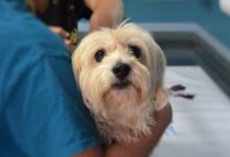A few extra pounds might seem harmless — even cute — on your dog. But when that weight starts adding up, it can lead to obesity, a serious condition that puts your pup at risk for major health problems.
Obesity can drain your dog’s energy, strain his joints and even shorten his lifespan. Here’s how to tell if your dog is carrying too much weight — and what you can do to help him get back on track.
How Do I Know If My Dog Is Obese?
Obesity is more than just being a bit chubby. Obese dogs are significantly overweight and often already showing signs of other health issues because of it.
While an overweight dog is roughly 10–20% above ideal weight, an obese dog is typically 30% or more overweight.
Common signs include:
- Trouble walking, running or getting up
- Difficulty breathing or getting tired very quickly
- Hesitation or refusal to climb stairs or hop into the car
Obese dogs frequently show early symptoms of joint problems — and the heavier they get, the harder exercise becomes, creating a cycle that’s tough to break.
What Is a Body Condition Score?
Vets use a tool called a body condition score (BCS) to determine whether your dog is underweight, at a healthy weight or overweight.
Here’s what to look for at home:
- Feel the ribs: You should be able to feel them easily without pressing hard.
- Look from above: Your dog should have a visible waist, not a barrel-shaped body.
- View from the side: His belly should tuck upward — not hang or bulge.
If your pup resembles a “stuffed sausage,” it’s a sign he may need some help.

Common Causes of Obesity in Dogs
Most cases come down to a simple imbalance: more calories going in than being burned off. But several other factors can play a role, including:
- Medical conditions: Hypothyroidism, Cushing’s disease, diabetes, joint disease, pregnancy or medication side effects
- Age: Older dogs tend to slow down and burn fewer calories
- Breed: Some breeds are genetically prone to weight gain
- Spay/neuter: Hormonal changes can affect metabolism
If your dog is gaining weight despite a normal diet and routine exercise, it’s time to see the veterinarian — there could be an underlying issue.
Health Problems Linked to Obesity
Obesity can cause or worsen many diseases, including:
- Osteoarthritis
- Diabetes
- Heart disease and high blood pressure
- Certain cancers
- Bladder stones
- Increased risks with anesthesia
Obese dogs also tend to have shorter lifespans, which is why addressing weight gain early is so important.
How To Treat Obesity in Dogs
Before starting any weight-loss plan, your vet will rule out medical causes. Once health issues are addressed, weight loss usually involves three key steps:
1. Switch to a Veterinary-Approved Weight-Loss Diet
Prescription weight management diets from brands like Hill’s, Royal Canin or Purina are often the most effective. These foods are designed to:
- Reduce calories without reducing portion size
- Increase fiber to keep your pup full
- Support lean muscle while burning fat
Always check with your vet before switching foods.
2. Measure All Meals — and Treats
Treats should make up no more than 10% of your dog’s daily calories. It’s incredibly easy to overdo it, so measuring meals and being mindful of extras can make a huge difference.
Try offering alternative rewards like playtime, cuddles or extra walks.
Try these Purina Pro Plan Veterinary Diets Gentle Snackers Low Fat Dog Treats from Amazon
3. Increase Daily Exercise
Movement is essential. Most dogs need 30–60 minutes of physical activity each day, but overweight dogs may need even more (introduced gradually).
Great ways to help your dog burn calories include:
- Longer or more frequent walks
- Fetch and puzzle toys
- Playtime at the dog park
Preventing Obesity in Dogs
Keeping your dog at a healthy weight is much easier than helping him lose weight. You can reduce the risk of obesity by:
- Feeding appropriate portions
- Choosing a high-quality diet
- Limiting treats
- Prioritizing daily exercise
- Scheduling regular vet visits
- Watching for small changes in weight or shape
If you notice your dog is getting rounder or slowing down, don’t wait — early action can prevent long-term health issues.
The Bottom Line
If you suspect your dog is obese, talk to your veterinarian about a personalized weight-loss plan. With the right diet, exercise routine and support, your pup can return to a healthy weight and enjoy a happier, more active life.
Let your dog’s transformation story start today — one walk, one cup and one healthier choice at a time.
We independently pick all the products we recommend because we love them and think you will too. If you buy a product from a link on our site, we may earn a commission.











